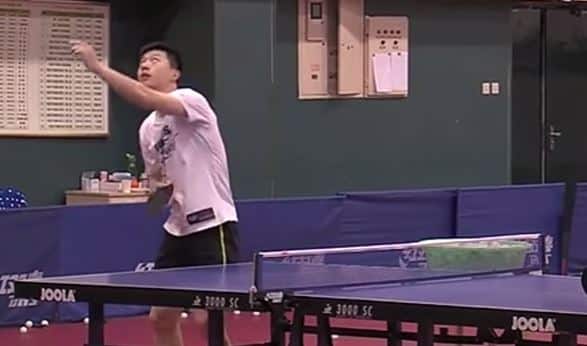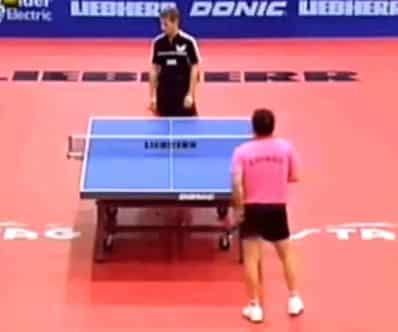Anticipating shots is very important in table tennis as it gives you that extra millisecond to react in the best way possible to your opponent’s shot.
It’s something that occupies a large portion of the way the game is played. Another large portion is reacting to shots you did not anticipate or have little time to prepare for.

There are shots that you feel lucky to get a paddle on and even luckier to put the return in play. However, with just a few tweaks to your game, you can do much more with those shots.
Table of Contents
ToggleReturn a ball with less effort
First of all, keep in mind the harder your opponent hits it at you, the harder you can return it with less effort.
Just like in baseball, if you get a hard fastball down the middle, it’s harder to catch up with, but it takes less of a swing to knock it out of the park.
The key is in your grip, the angle of your paddle, and the swing.
The lack of swing is a better way to put it.
If you get a shot you have little time to react to, the best response is more of a punch or a flick than a swing. Also, the tendency is to back up when a hard hit is coming.
If you catch the ball on the rise and angle your paddle in such a way so you can punch it back, it greatly reduces your prep time and often produces a solid return.
Adding just enough wrist flick into it will give it the necessary spin to fall into the court. This shot can catch your opponent off guard and keep you in the game against a flame thrower.
The Underrated but Deadly Flick
The flick is an essential and advantageous skill to master. It can help give you a jump on your opponent’s short serve and, when used correctly, can even score you a few quick points.
Mixing it with the chop and push gives you great variety in your returns. Both are like mini topspins but are trickier than they sound because of the limited backswing.
To execute the forehand flick:
Set in your ready position. When the ball comes short to your forehand side, slide your closest foot to the ball forward up close to the table. Extend your arm out to reach the ball and then bring your forearm up, spinning the ball forward, keeping your wrist reasonably stiff.
Used with less or more spin and combined sometimes with a simple push over the net can give your opponent great difficulty returning the ball, leaving you to control the game and attack.
Watch Timo Boll as he executes his forehand flick. His wrist is reasonably rigid, and he approaches the ball as he will chop, but he swings his arm up and spins the ball…
To perform the backhand flick:
In the ready position, when the ball comes to your backhand side, slide the closest foot to the ball (depending on whether the ball is hit far- backside or in the middle, use both feet to slide up) forward and extend your arm out to the ball.
The wrist is a little looser on the backhand. When more advanced, adding in a flick of the wrist can help spin and is tricky for your opponent to read. But mastering it first without the wrist flick will give you better accuracy and stability to increase your skill. The same goes with the forehand flick.
Notice Timo on the backhand flick how he uses more of his wrist upon contact. It is trickier to control and should be practiced when more advanced…
Because of the position he’s in with respect to the ball, he uses the same foot as his forehand flick to move forward near the middle of his body. But the other foot should be used on far backhand shots.
Returning Shots Hit To Your Playing Elbow
Many players aim towards the playing elbow of their opponent. They do so to create confusion about whether the opponent should play with their forehand or backhand.
So how can you return these shots?
Good footwork is the beginning of the answer to this question.
Footwork allows you to move efficiently and get into your ideal position for the shot.
Since it makes no sense to give your opponent a chance to lodge the ball down your throat, having good footwork is the first step to master.
Another good rule to follow when faced with a ball played down the middle is to use your forehand.
A few players can consistently return the shot with their backhand, but the majority can’t.
However, there are variables. For instance, if you’re close to the table and your opponent strikes the ball, then play the backhand. It also works when the ball is moving at a high rate of speed. I would suggest pushing the ball back over the net close to the net.
If you find yourself a little back from the table, I would suggest playing the ball with your forehand.
Whatever the case, when the ball is hit to your playing elbow (indecision point), you must decide and COMMIT to it.
If you hesitate, your return will be rushed and cramped, most likely resulting in a lost point.
Well, it also depends a lot on where your position is relative to the table. If you have been pushed far onto your backhand side (far-left for proper handles), then you should be tactical and use a good forehand smash down the line to give yourself an excellent chance to maneuver and find a position back on the table and level out your playing field.
If you are far on your forehand and it’s getting played into your body (indecision point), down the line is harder to play, but you could use a backhand chop try to drop the ball short, adding as much side spin as possible.
When out of position and firing at the indecision point, you need to take advantage if you can.
Is It Legal Return If The Ball Touches Our Playing Hand?
Many people wonder if it is whether legal or not for a return if the ball touches our playing hand? Well, the answer is yes, it is legal. It will only be considered illegal only if the racket is still in your hand. To be more precise, you can hit everything up to the wrist of your playing hand. Thus, it is legal as long as there is a single movement.

It is okay in the rule of table tennis a player to hit the ball up to the wrist of your playing hand, but as mentioned above, only if your bat is still in your hand.
Always Follow The Rules of ITTF
The new rule introduced by ITTF claims that the ball can touch both your hand and the racket, and that’s legal too! This is an excellent new rule for some players but can be bad for other players. However, as long as you stick to the rule by not making any mistake, it should not significantly impact when you are playing in a tournament.
When the ball touches the racket and then your hand (or hand then racket), it is only legal if it is not deliberate. Deliberately striking the ball twice breaks the rule as stated in the ITTF table tennis rules in 2.10.01.06 – “if an opponent deliberately strikes the ball twice in succession;”
How Is The Umpire Supposed To Be Sure It is Deliberate?
It is the umpire’s decision, that’s why they sit in the chair. If the umpire thinks you have deliberately struck the ball twice, he/she will award the point to your opponent.
If you hit the ball twice during one smooth stroke, odds are you didn’t do it on purpose. An umpire will not give the point to your opponent. If, however, your stroke wasn’t all that smooth (e.g., you first the ball up, after which you smash), the point will go to your opponent. At least, that’s what the umpires in my region told me.
After all, there is no ironclad rule. Still, the general practice (and recommendation to umpires) is that if the double-hit (or triple-hit) was performed as one stroke (in one motion), then it is not deliberate, and therefore legal. The rule was changed in 2008, but surprisingly enough, many advanced club players are still not aware of it.
Related post:

Warren Davies
Hi, I’m Warren Davies, a table tennis addict who loves sharing tips, reviews, and everything you need to level up your game. I’ve spent years playing, testing gear, and geeking out over the sport, and I’m here to make things simple and fun for players of all levels. When I’m not writing, you’ll probably find me perfecting my forehand or trying out the latest paddle.









1 thought on “Simplify for Better and Quicker Returns”
Hello,
Nice tips you have here. I remember when I first played table tennis, I have a hard time practicing on the backhand flick, during that time that’s my weakness. But through continuous practice, I conquered that weakness.
Cheers,
Andro